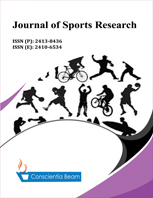The Effect of Nasal Breathing Versus Oral and Oronasal Breathing During Exercise: A Review
DOI:
https://doi.org/10.18488/journal.90.2020.71.1.10Abstract
Historically, exercise physiologists believed that humans produce the greatest physical work by breathing orally. Recently, however, authors from the fields of medicine, health and exercise have described the potential benefits of limiting breathing to the nasal airway during exercise, but actual effects have been infrequently examined in the literature. The purpose of this review was to examine the effects of nasal breathing as compared to oral and oronasal breathing during exercise from the available peer reviewed literature. Studies were identified using six search terms in Google Scholar. All related descriptive studies were included as were experimental studies with the following three criteria: a repeated measures design, randomization of condition order, and valid measurement techniques. The search results yielded a total of 30 published articles as of August, 2019, and both descriptive (n=7) and experimental studies (n=23) were reviewed for the effects of nasal breathing on exercise. The evidence suggests that exclusively nasal breathing is feasible for most people at moderate levels of aerobic exercise without specific adaptation, and that this breathing approach may also be achieved during heavy and maximal levels of aerobic exercise following a sustained period of use. Benefits of nasal breathing include a reduction in exercise induced bronchoconstriction, improved ventilatory efficiency, and lower physiological economy for a given level or work. The use of nasal dilation devices can increase the work intensity achieved during exercise while breathing nasally. Further research on the effects of nasal breathing during exercise is needed.

